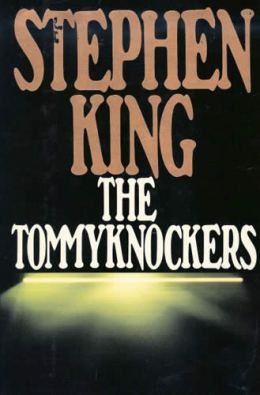By STEPHEN KING (Putnam; 1987)
This is the widely hailed worst novel ever written by Stephen King, and it is indeed pretty lousy. How curious, then, that three decades after its initial publication THE TOMMYKNOCKERS is being reassessed as a “misunderstood classic” and a “transcendental visionary experience.” Sorry, but I say people got it right the first time.
The novel, for starters, is highly derivative. It cribs shamelessly from QUATERMASS AND THE PIT, INVASION OF THE BODY SNATCHERS, “The Colour Out of Space,” “At The Mountains of Madness” and quite a few other sources (King at one point even name checks one of his likely influences: Peter Straub’s FLOATING DRAGON). King also references many of his own works (including THE DEAD ZONE, FIRESTARTER, THE TALISMAN and IT), but the Stephen King novel THE TOMMYKNOCKERS most closely resembles is one that appeared fourteen years later: DREAMCATCHER, an unwieldy mess of a book written while King was recuperating from a catastrophic car accident. THE TOMMYKNOCKERS was likewise drafted in the wake of a calamity, in this case its author’s substance abuse, which nearly destroyed his marriage and is referenced throughout the text.
The opening chapters would seem to promise a good, or at the very least focused, story. They describe a metallic something lodged in the Earth, discovered by one Bobbi Anderson, a pulp novelist residing in a Maine shithole. The something is revealed to be a centuries-old flying saucer that when unearthed emits a toxin that causes Anderson, and the people of the surrounding town, to transform into alien “Tommyknockers.” As such they’re driven to manically construct elaborate gadgets or modify existing ones, resulting in wild contraptions that include a super tractor, a flying Coke machine and a mind reading typewriter.
Also in on the fun is Jim Gardener, a poet who likes to deliver drunken lectures about the Chernobyl meltdown and the dangers of nuclear power—with his claims presented in boldface so we understand their relevance to the story (nuclear weapons being, apparently, a more destructive variant on the types of gadgets the Tommyknockers create), although what comes through far more clearly is King’s insight into the minutia of drunken behavior. Gardener, luckily, has a metal plate in his head, which protects him somewhat from the Tommyknockers’ psychic influence.
Had King maintained his focus this unwieldy 544 page book might have been interesting. But King, likely due to his addictions, is given to lengthy digressions and detours—as critic Grady Hendrix sums it up in an online write-up, “The point-of-view flips from character to character like someone with ADD and a remote control, never settling long enough to become comfortable, deflating its own narrative drive every time it switches.” That write-up, I should add, is among the recent positive reappraisals of THE TOMMYKNOCKERS, proving that even its admirers can’t help but recognize its shortcomings.
There are some affecting passages, such as an “At The Mountains of Madness” inspired one in which alien corpses are discovered in the ruins of the spaceship, resulting in speculation about what caused the thing to crash (an inter-alien fight, apparently). Keep in mind, though, that Stephen King himself once dismissed “At the Mountains of Madness” as an “ambitious failure,” which perfectly describes THE TOMMYKNOCKERS.

